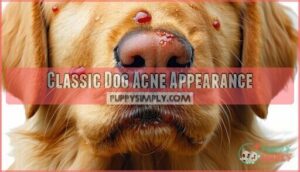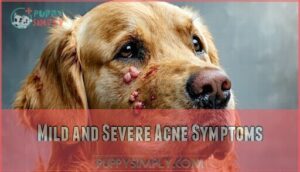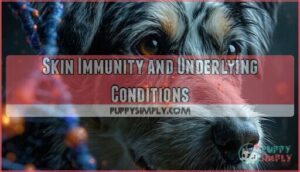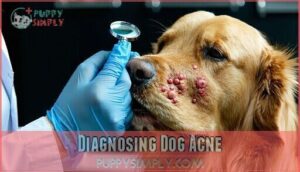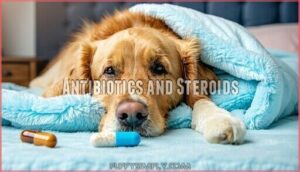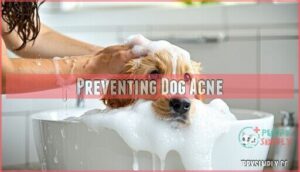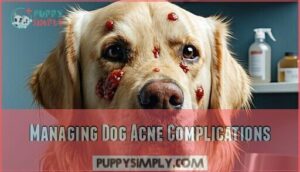This site is supported by our readers. We may earn a commission, at no cost to you, if you purchase through links.
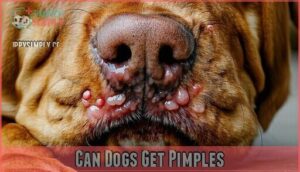 Yes, dogs can get pimples just like humans do.
Yes, dogs can get pimples just like humans do.
Canine acne typically appears on your dog’s chin, muzzle, and lips as small red bumps or blackheads.
Young dogs are most prone to breakouts, especially short-haired breeds like Boxers and Bulldogs.
Poor hygiene, trauma from rough play, or irritation from food bowls can trigger these pesky bumps.
While most cases are mild and clear up on their own, some dogs develop more serious infections that need veterinary attention.
The key is knowing what to look for and when simple home care isn’t enough to keep your pup’s skin healthy, and understanding canine acne is crucial for proper hygiene.
Table Of Contents
- Key Takeaways
- Dog Acne Overview
- Can Dogs Get Pimples
- Dog Acne Symptoms
- Diagnosing Dog Acne
- Treating Dog Acne
- Preventing Dog Acne
- Managing Dog Acne Complications
- Frequently Asked Questions (FAQs)
- Is it okay to pop a pimple on a dog?
- Why is there a pimple-like bump on my dog?
- What does acne on a dog look like?
- How long does dog acne typically last?
- Can adult dogs develop acne later in life?
- Is dog acne contagious to other pets?
- What foods might trigger dog acne outbreaks?
- Should I pop my dogs pimples myself?
- Conclusion
Key Takeaways
- Yes, dogs can get pimples – Your dog can develop acne just like humans, especially on their chin, muzzle, and lips as red bumps or blackheads.
- Young dogs and certain breeds are most at risk – Puppies between 3-12 months old are most prone, particularly short-haired breeds like Boxers and Bulldogs.
- Don’t pop your dog’s pimples yourself – You’ll risk pushing bacteria deeper, causing scarring and infections that’ll make the problem worse.
- Most cases clear up with proper care – Mild acne often resolves on its own with good hygiene, but see your vet if you notice severe swelling, pus, or signs of infection.
Dog Acne Overview
Yes, dogs can get pimples just like humans do, and it’s more common than you might think.
Dog acne typically affects young pups between 3 to 12 months old and shows up most often on their chin and muzzle area.
Most puppy acne appears on the chin and muzzle during those playful early months.
Causes of Dog Acne
Unlike human acne, dog acne stems from hygiene and genetics rather than hormones.
Broken hair shafts from playful chin rubbing inflame follicles, letting bacteria invade.
Skin trauma from scratching or rough play damages pores, while hormonal imbalance during puppyhood can trigger blocked follicles.
Poor hygiene creates the perfect storm for bacterial skin infection and dog skin issues to develop.
Risk Factors for Dog Acne
Several risk factors increase your dog’s chances of developing dog acne.
Genetic predisposition plays a major role, especially in shortcoated dogs whose broken hair shafts easily inflame follicles.
Poor hygiene impact allows dirt and bacteria to accumulate, while trauma influence from rough play or face rubbing damages skin.
Allergies to food or environmental triggers cause inflammation, and hormonal problems during adolescence boost oil production, creating perfect conditions for acne development.
Sometimes, these pimples are caused by bacterial and oil blockage.
Breed Predisposition
While understanding the risk factors helps identify vulnerable pups, certain breeds face higher odds due to genetic predisposition.
Short-haired breeds like Boxers and Bulldogs inherit traits that make their follicles more susceptible to inflammation and blockage. Bacterial infections can exacerbate the condition if left untreated.
- Boxers, Bulldogs, and Great Danes top the list for genetic predisposition to dog acne
- Short-coated dogs experience more follicular trauma from broken hair shafts
- Genetic inheritance passes acne susceptibility from parents to offspring
- Early intervention becomes critical for breeds with known predisposition patterns
Can Dogs Get Pimples
Yes, dogs can get pimples, just like humans.
Dog acne and canine acne are common skin conditions that affect many pets.
These dog skin bumps typically appear on the muzzle and chin area.
Pimple location varies by breed differences, with short-haired breeds like Boxers and Bulldogs being more prone.
Acne severity ranges from mild red bumps to infected pustules.
While basic home care helps, veterinary costs for severe cases can add up.
Most dog pimples resolve with proper treatment, making early intervention key for your pet’s comfort.
Regular veterinary check-ups are essential for thorough evaluation, ensuring the best outcome with early intervention and veterinary costs considered.
Dog Acne Symptoms
You’ll notice dog acne symptoms most often on your pup’s muzzle, chin, and lips as small red bumps or pus-filled pimples.
These breakouts can range from mild raised bumps to severe swelling that makes your dog’s face sore and uncomfortable, often causing discomfort.
Classic Dog Acne Appearance
You’ll spot classic dog acne on your pup’s muzzle, especially around the chin and lips.
Look for red bumps that resemble teenage acne – these are the telltale signs of canine acne.
The pustules often cluster in these areas where your dog’s face meets food bowls or rubs against surfaces.
Dog chin acne appears as small, raised lesions that can make your pet’s muzzle look irritated and inflamed.
Mild and Severe Acne Symptoms
Your dog’s acne symptoms can range from barely noticeable to quite concerning.
Mild cases show small red bumps on the muzzle and chin that might cause occasional facial rubbing. Severe acne brings painful swelling, pus-filled bumps, and noticeable hair loss around affected areas.
Watch for these key dog acne symptoms:
- Red bumps that appear raised and inflamed on the chin area
- Skin scabbing from ruptured pimples or excessive scratching
- Dog skin inflammation causing visible swelling around the muzzle
- Itching that leads to persistent facial rubbing against furniture
Severe cases often involve scarring if left untreated.
Skin Immunity and Underlying Conditions
Your dog’s skin immunity acts as the first line of defense against acne, but underlying medical conditions can weaken this barrier.
Allergies, hormonal imbalance, and immune system dysfunction create immunity triggers that disrupt normal skin function.
Stress factors and nutritional impact also play roles, while genetic predisposition makes some dogs more vulnerable.
Systemic diseases can compromise your pet’s natural defenses, making acne more likely to develop and persist, due to underlying medical conditions and genetic predisposition.
Diagnosing Dog Acne
When you notice those red bumps on your dog’s chin or muzzle, getting an accurate diagnosis is the first step to effective treatment.
Your veterinarian will typically diagnose dog acne based on the clinical appearance and your pet’s age, though more complex cases may require additional testing to rule out other skin conditions, which is crucial for effective treatment.
Clinical Appearance and Diagnosis
Your vet’s trained eye can spot canine acne through visual examination of the acne location, typically the muzzle and chin.
They’ll assess lesion types – pustules, papules, or comedones – and evaluate severity.
This clinical approach helps distinguish dog acne from other skin conditions.
Most cases don’t require extensive diagnostic tests, making veterinary diagnostics straightforward for experienced practitioners recognizing classic pimple patterns, using a clinical approach.
Skin Biopsy and Cultures
When standard diagnosis isn’t enough, your vet might recommend a dog skin biopsy.
This procedure removes a small tissue sample under local anesthesia for lab analysis.
Bacterial culture and cytology help identify specific organisms causing infection.
Sample collection from pustules guides targeted treatment through results interpretation.
Veterinary diagnostics like biopsy provide definitive answers when acne doesn’t respond to typical therapy, offering a way to pinpoint the cause and apply targeted treatment.
Distinguishing Acne From Other Skin Conditions
While examining your dog’s skin bumps, you’ll need to distinguish dog acne from other common skin conditions.
Acne vs allergies shows localized chin bumps rather than widespread irritation. Acne vs infections typically appears as sterile pustules, while infections spread rapidly.
Acne vs cysts reveals smaller, inflamed bumps versus larger, fluid-filled masses. Acne vs folliculitis shows similar symptoms but different underlying causes.
Breed predispositions help identify true dog acne in susceptible breeds like Boxers and Bulldogs.
Treating Dog Acne
When your dog’s acne becomes bothersome or infected, effective treatment options can help clear up those pesky bumps and prevent complications.
The right approach depends on how severe the condition is and whether bacteria have gotten involved, which determines the best course of action to take for your dog’s acne.
Topical Treatments and Medications
Topical treatments offer targeted relief for your dog’s acne without affecting their whole system.
Benzoyl peroxide shampoos and gels work as the gold standard, flushing follicles and reducing bacteria.
Medicated wipes containing chlorhexidine provide convenient daily cleaning, while topical antibiotics like mupirocin tackle surface bacteria, and antifungal solutions address yeast overgrowth.
A variety of products can help with treatment, and these dog acne treatment options typically show improvement within weeks.
Antibiotics and Steroids
When topical treatments aren’t enough, your vet might prescribe antibiotics for bacterial skin infection or steroids for severe inflammation.
Oral antibiotics like amoxicillin treat infected lesions over 4-8 weeks, while steroids reduce swelling.
Combination therapy addresses both infection and inflammation.
Follow dosage guidelines carefully—antibiotic resistance and steroid side-effects can occur with improper use.
Treatment duration varies based on severity.
Natural Remedies and Preventive Measures
Natural remedies can complement professional treatment for dog acne prevention.
Gentle cleansing with diluted apple cider vinegar helps balance skin pH, while aloe application soothes inflammation.
These dog acne home remedies work best alongside proper veterinary care.
Dog-specific shampoos maintain the skin’s pH balance.
Natural Dog Acne Prevention Methods:
- Herbal remedies – Green tea compresses reduce bacterial growth
- Dietary changes – Omega-3 supplements support skin health
- Gentle cleansing – Daily face washing prevents oil buildup
- ACV benefits – Diluted vinegar acts as natural antiseptic
- Aloe application – Pure gel calms irritated skin naturally
Preventing Dog Acne
You can take several steps to help prevent dog acne from developing or recurring in your pet.
The key is maintaining good hygiene, protecting your dog’s skin from trauma, and addressing any underlying health issues that might contribute to the problem.
This approach helps in preventing dog acne by focusing on protecting your dog’s skin and overall health.
Regular Skin Care Routine
A consistent dog skin care routine keeps your pup’s skin healthy and prevents acne flare-ups. Start with gentle cleansing using a dog-specific shampoo weekly or as needed.
Regular cleaning of food bowls and bedding reduces bacteria buildup. Routine brushing removes dead skin cells and promotes circulation.
Don’t forget diet impact—quality nutrition supports skin health. Hydration importance can’t be overstated; fresh water helps maintain skin moisture.
Basic sun protection prevents additional skin damage during outdoor adventures. Consider using specialized acne treatments for persistent issues, which can be a key part of a skin care routine.
Preventing Trauma to The Muzzle or Chin
Keep your dog’s face safe from bumps and scrapes that can trigger acne.
Choose Safe Toys without sharp edges, and make certain Supervised Play to prevent rough face-rubbing against hard surfaces.
Provide Soft Surfaces for resting and eating.
Replace plastic bowls with stainless steel or ceramic Clean Bowls, as plastic can harbor bacteria.
Use Proper Harnesses instead of collars to reduce muzzle and chin trauma during walks.
Simple prevention steps protect your pup’s sensitive facial skin.
Managing Underlying Medical Conditions
Several underlying medical conditions can trigger dog acne, making proper management essential for prevention.
Hormone imbalance from Cushing’s disease increases oil production, clogging pores. Allergy control helps prevent scratching that damages skin.
Immune support strengthens your dog’s natural defenses against infections. Infection control addresses bacterial or fungal issues early.
Regular vet checkups catch these conditions before they worsen your dog’s skin health, providing essential care and prevention.
Managing Dog Acne Complications
Even with proper treatment, dog acne can sometimes lead to serious complications that require immediate attention.
You’ll need to watch for signs of infection, scarring, or worsening skin conditions to keep your pup comfortable and healthy, which is crucial for preventing complications.
Infected Dog Acne and Abscesses
When your dog’s acne becomes infected, you’re facing a more serious situation.
Don’t panic, but infected dog acne needs immediate veterinary attention to prevent serious complications.
Infected dog pimples can turn into painful abscesses filled with pus. Staphylococcus bacteria often causes these pustule infections, making antibiotic treatment necessary.
Without prompt care, antibiotic resistance can develop, complicating treatment.
- Watch for increased swelling, heat, and pus discharge from infected areas
- Contact your vet immediately if pustules rupture or abscess formation occurs
- Follow prescribed antibiotic courses completely to prevent infection severity from worsening
Scarring and Skin Damage
Severe acne cases can leave lasting marks on your dog’s skin.
When follicles rupture deeply, scar tissue forms that may never fully heal.
This permanent damage often appears as thickened patches or hairless spots on the muzzle and chin.
Regular veterinary care can also address underlying skin disorders that contribute to acne and scarring.
| Scarring Type | Appearance |
|---|---|
| Scar tissue | Thickened, raised patches |
| Hyperpigmentation | Dark spots or discoloration |
| Permanent hair loss | Bald areas where follicles died |
| Skin lesions | Irregular texture or depressions |
Bleeding wounds from ruptured pimples create the worst skin trauma.
The deeper the damage, the higher your hyperpigmentation risks become.
Prevention beats treatment every time.
Secondary Infections and Worsening Conditions
Untreated acne opens the door to serious complications that can spiral out of control.
When bacterial skin infection takes hold, your dog’s immune response kicks into overdrive, creating a cycle of inflammation that’s tough to break.
Watch for these warning signs:
- Abscess formation – painful, pus-filled pockets that signal deep infection
- Systemic infections – fever and lethargy when bacteria enter the bloodstream
- Staphylococcus overgrowth – aggressive bacteria that resists basic treatments
Without prompt antibiotics, scarring prevention becomes nearly impossible as infection spreads deeper into tissue layers.
Frequently Asked Questions (FAQs)
Is it okay to pop a pimple on a dog?
Picture squeezing a balloon too hard—it bursts messily.
Never pop your dog’s pimples yourself. You’ll push bacteria deeper, cause scarring, and risk infection.
Instead, use medicated shampoos or see your vet for proper treatment.
Why is there a pimple-like bump on my dog?
That bump could be acne, which commonly affects young dogs, especially short-haired breeds like Boxers and Bulldogs.
It’s caused by clogged hair follicles, trauma from rubbing, or bacterial infections requiring veterinary evaluation.
What does acne on a dog look like?
Dog acne typically shows up as red, raised bumps on your pup’s muzzle, chin, and lips.
You’ll notice small pustules, blackheads, or inflamed spots that might cause swelling and tenderness around their face.
How long does dog acne typically last?
While you’d expect puppy acne to clear up quickly, it’s surprisingly stubborn and typically lasts 4-12 weeks with proper treatment.
Mild cases resolve faster, but severe infections need longer antibiotic courses to heal completely.
Can adult dogs develop acne later in life?
Yes, adult dogs can develop acne later in life, though it’s less common than in puppies.
Adult acne usually stems from underlying conditions like allergies, hormonal imbalances, or skin infections rather than typical adolescent causes.
Is dog acne contagious to other pets?
No, dog acne isn’t contagious to other pets.
It’s caused by clogged hair follicles and genetics, not infectious agents that spread between animals.
Your other pets won’t catch acne from an affected dog.
What foods might trigger dog acne outbreaks?
Food allergies can trigger acne outbreaks in your dog.
Common culprits include chicken, beef, dairy, wheat, corn, and soy.
You’ll want to work with your vet to identify specific triggers through elimination diets.
Should I pop my dogs pimples myself?
Like opening Pandora’s box, popping your dog’s pimples can trigger bigger problems. Don’t squeeze them yourself—you’ll risk infection, scarring, and deeper inflammation. Let your vet handle it properly.
Conclusion
Just like their human companions, can dogs get pimples? Absolutely, and now you’re equipped with the knowledge to handle them.
Most cases resolve with proper hygiene and gentle care, but don’t hesitate to consult your vet if symptoms worsen or persist.
Your furry friend depends on you to recognize the signs and take action when needed, with consistent prevention and prompt treatment, you’ll keep your dog’s skin healthy and comfortable for years to come.
- https://www.thesprucepets.com/do-dogs-get-pimples-4799659
- https://www.petmd.com/dog/conditions/skin/c_dg_acne
- https://www.pawlyclinic.com/blog/dog-pimples-on-body-causes-symptoms-treatment
- https://lovelandregional.com/blog/pimples-on-dogs/
- https://www.purina.co.uk/articles/dogs/health/skin-fur-ears/dog-acne-information

